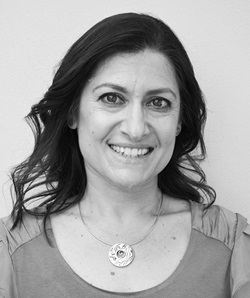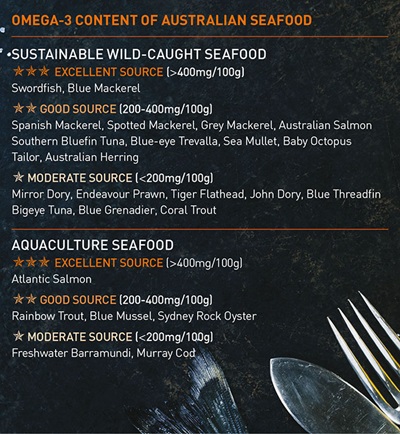Combined information on the health benefits and sustainability of Australian fish stocks will help health professionals confidently recommend that clients eat more Australian seafood
By Catherine Norwood
 Photo: Shutterstock
Photo: Shutterstock Want to protect your brain, heart, eyesight and bones? Evidence from a growing body of international research shows that eating fish and other seafood has a powerful role to play in doing just that.
But confusion over which species are sustainable has often stymied Australian healthcare professionals who want to recommend that their clients eat fish.
To address this issue the FRDC has worked with dietitians to create new resources specifically for health professionals that combine information on both health benefits and sustainable Australian species.
The Status of Australian Fish Stocks (SAFS) reports already provide a publicly accessible and rigorously tested scientific benchmark for the sustainability of commercially wild-harvested fish species.
The reports are updated every two years, and the latest release, in March 2019, includes 120 species that make up the bulk of available Australian seafood.
Supplementing this is the FRDC’s new Health Care Professionals Resource on Sustainable Seafood, prepared by dietitian and nutritionist Nicole Senior, from Professional Nutrition Services in Sydney. In preparing the resources, she worked with fellow dietitian Shawn Somerset from the University of Canberra; and independent consultants Gabrielle O’Kane, who has researched sustainable seafood recommendations in nutrition professionals, and Michele Walton, who specialises in nutrition communications. The resource package has three elements: a review of available evidence about the health benefits of seafood; resource material combining health evidence with general information about seafood and sustainable Australian seafood species; and a collection of recipes.
Gathering health evidence
 Nicole Senior, Nutritionist
Nicole Senior, Nutritionist Nicole Senior says the FRDC has identified healthcare professionals as a key influencer group to Australians selecting food and an excellent conduit for behaviour change in the broader community.
The key audience for the resource material includes dietitians, nutritionists, primary healthcare nurses and public health practitioners. Secondary influencers who will also be included are home economists (such as food educators), food scientists and food technologists. All these groups share a commitment to scientific evidence that is also shared by the FRDC.
The evidence review written by Shawn Somerset has brought together international research findings about seafood and health, to underline the health benefits of seafood consumption. It addresses not just disease-related findings, but also the protective benefits of seafood that consumers can proactively take advantage of, to optimise their health throughout life. Shawn Somerset is no stranger to researching the health benefits of seafood, having worked, along with Mark Wahlqvist, on ‘What’s so healthy about seafood?’ available on the FRDC website. “We looked for evidence showing seafood as protective from chronic disease, but also as a core food for optimal health and development, and we found plenty,” Nicole Senior says.
Key findings include:
- Two serves of fish and other seafood a week is recommended as part of many national dietary guidelines, including Australia’s.
- Seafood consumption is associated with better child health outcomes.
- Fish may help reduce the risk of obesity and improve cognitive performance in children and adolescents.
- Fish in the diet of children may reduce their risk of asthma.
- Evidence supports fish and other seafood as a cardioprotective food.
- Omega-3 fatty acids in seafood are important for metabolic health.
- Fish consumption is associated with better bone health in older people.
- Fish and other seafood consumption is associated with reduced risk of depression.
- Fish consumption supports eye health.
Sustainability links

The second part of the resource package explains seafood sustainability in more detail, focusing on Australian seafood species, and Nicole Senior says SAFS provides the baseline information for this.
“We wanted to provide an evidence-based guide to sustainability in Australia and how it is determined, and to introduce healthcare professionals to the SAFS reports. This audience does demand quite high levels of good quality information supported by science, which SAFS provides.”
The launch of the new SAFS app, available for iOS and Android devices, in addition to the SAFS website, will make the information even more accessible, she says. SAFS provides information on wild-caught species, and identifies the status of different stocks of the same species; a particular fish may be sustainable in one fishery, but have a different status in another fishery. For the 120 species in SAFS, there are 406 different fish stocks assessed.
While SAFS does not assess broader sustainability issues, such as harvesting techniques and broader environmental impacts, it does provide an important starting point for selecting sustainable seafood.
The resource material also links to available information on the omega-3 status of Australian fish, as the long-chain omega-3s fatty acids specific to seafood are identified as important in optimising health.
Nicole Senior says an assessment at the start of the project found that healthcare professionals wanted online rather than printed resources.
They also wanted recipes to help clients, patients and communities to put sustainable seafood recommendations into action ‘on the plate’. This has led to the third part of the project, a collection of 24 sustainable seafood recipes.
Recipe resources
The aim was to find everyday, family-friendly meals that dietitians could recommend. These have been sourced from the Australian Healthy Food Guide, a magazine well known to dietitians and a trusted reference.
“We’ve been able to bring together a collection of 24 very approachable, economical family recipes for familiar dishes. And we modified them to include sustainable Australian seafood species,” Nicole Senior says.
The recipe collection is online, along with the evidence review and the resource material on sustainable seafood.
Newsletters from the professional associations of the targeted audience group will help to promote the new resources. These include the Dietitians Association of Australia, Public Health Association of Australia, the Australian Primary Health Care Nurses Association, the Home Economics Institute of Australia and the Australian Institute of Food Science and Technology.
Nicole Senior says the evidence supporting the health benefits, combined with the SAFS reports, shows that there is a lot of good news to share about Australian seafood and how well Australia is doing by international standards.
“Let’s hope we can encourage Australians to eat seafood twice a week, and to include more Australian product. About 70 per cent of the seafood we eat is imported, but our homegrown seafood is great quality and sourced from well-managed, sustainable fisheries. Health and sustainability are what many of us are looking for in our food and Australian seafood delivers that.”
FRDC Research Code: 2018-092
More information
Nicole Senior
(02) 9760 2187, 0407 261 803
Professional Nutrition Service





